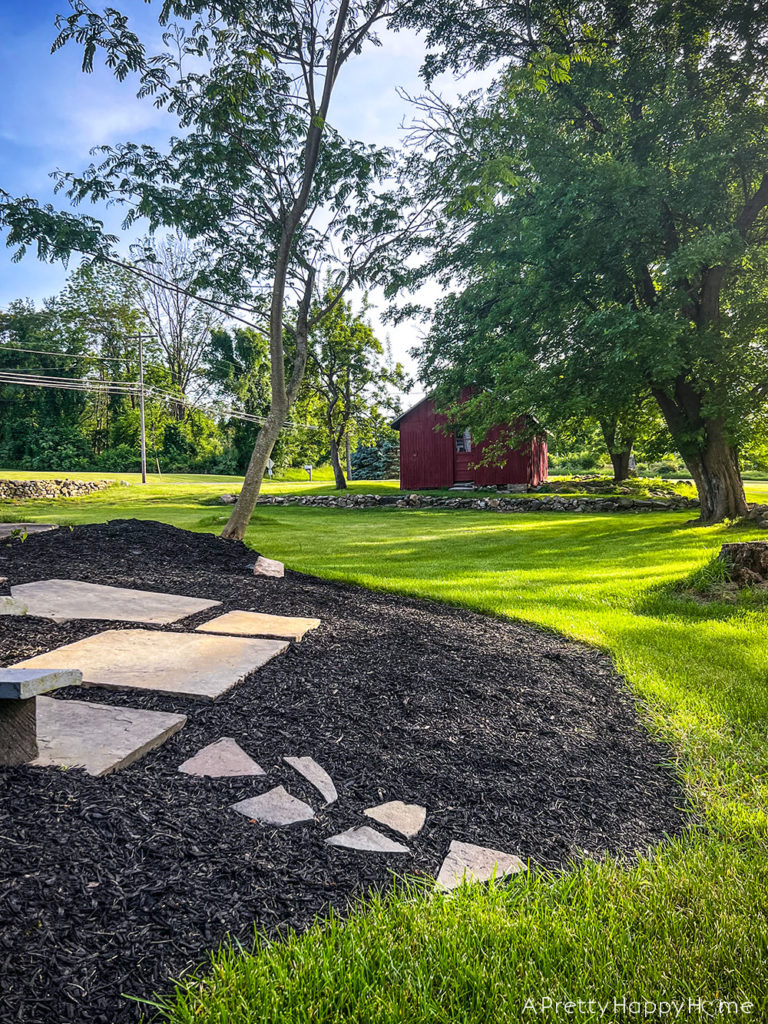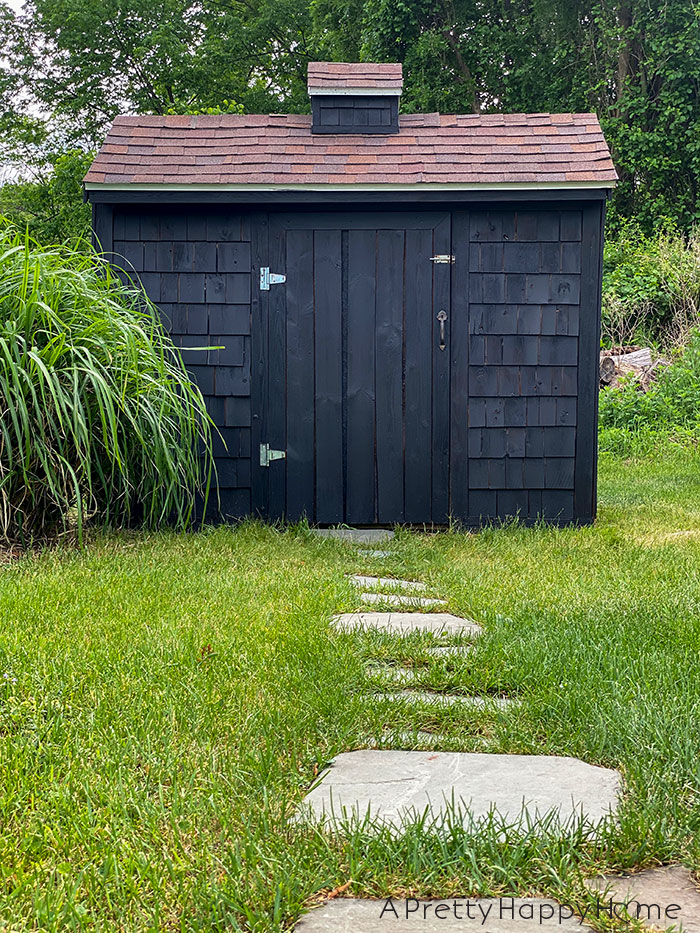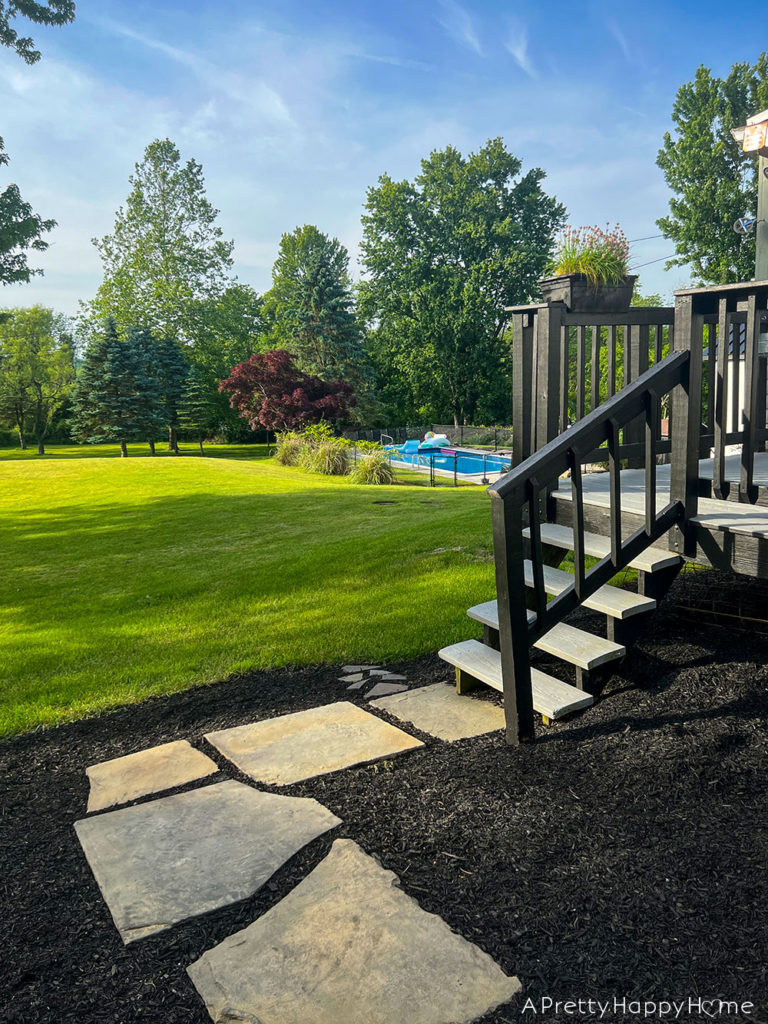
What Happens When You Set Flagstones Directly On The Ground
What happens when you set flagstones directly on the ground?
It depends.
That’s such a terrible answer, right?
We are not experts, but we do have experience setting flagstones directly on the ground when creating paths. I’m sharing what we’ve learned here – the good and the bad.
Hopefully, our experience will help you make a more informed decision when deciding to DIY or hire a pro to build a flagstone path. Keep in mind that our experience is specific to soil and weather conditions in New Jersey. Where you live, conditions, and, therefore, your experience might be different when setting flagstones directly on the ground.
Remember, this feedback is specific to flagstone PATHS, not patios. You’ll see the type of paths we laid in the below pictures. I will address what we’d do with patios at the end of this post.
What happens if you set a flagstone path directly on grass?
We’ve done this! It wasn’t our best work, but it wasn’t the worst thing that ever happened.
You can plop a flagstone directly down on the grass. On the plus side, the grass will eventually grow up and around the stones and the path will look fine.
The big downside, which is why I wouldn’t suggest using this method is that the stones can move or shift around because you haven’t sunk them into the ground. We noticed this happening with some smaller flagstones when we drove over the path with the riding lawnmower.
(Large flagstones that take 2 or 3 adults to move are less likely to budge, but it’s not impossible.)
The fix to this situation is to dig out the grass and place the flagstones directly on the ground or dirt.
The other difficulty with setting flagstones directly on the grass is that it’s hard to level them and I don’t mean level from stone to stone. Although, that’s an issue too.
I mean that one stone, in particular, (or maybe all of them) might wobble when you step on it because it’s set on uneven grass or ground. Wobbly stones don’t scream “competent path builder!”
Whether any of this is a concern for you when laying a flagstone path across a grassy area is up for you to decide! You’re the master of your own destiny after all.
What happens if you set a flagstone path directly on dirt?
Setting flagstones directly on the ground or the dirt is where we have the most experience.
Typically, we will set the flagstone on the ground where we want it. Then use a shovel to edge around the flagstone. After that, we use the shovel to dig out the grass or dirt to the height that we want the flagstone to sit.
If the flagstone is going to be in an area where it will be surrounded by rocks or mulch, we will place it higher than if it’s going to be in a grassy area. In grassy areas, you need to consider the height of the stone as it relates to mowing the grass. In mulched or graveled areas, you need to consider the height of the flagstones as it relates to keeping the mulch or gravel off the top of the flagstone path.
The flagstones in the below picture are sitting ever-so-slightly above the mulch.
After the ground is dug out for the flagstone, it’s a matter of trial and error to make the flagstone level. We end up adding back a little bit of dirt here and there to get the stone to sit as level as possible.
Even if the spot where you are setting the stone is perfectly flat, the flagstone itself probably isn’t. That’s why it’s a bit of a dance when setting flagstones directly on the ground or dirt.
Please keep in mind that it is possible for the flagstones that have been situated directly on dirt to settle over time (likely over months and years, not days), so they might not stay as level as you originally set them.
If this happens, you’ll have to add more dirt back under the stone to relevel it or start over with a different type of base under the path.
Again, it’s up to you to decide the pros and cons of this method.
What happens if you set a flagstone path directly on mulch?
Should I admit that we’ve set flagstones directly on mulch? Okay, we have.
It’s not an ideal situation.
There was one instance where we wanted a flagstone path to bisect a flowerbed area that had a SUPER thick layer of mulch (4 – 6 inches deep). In this instance, you’ve either got to build up the ground or dirt where you want the flagstones to sit or you’ve got to take your chances with setting the flagstones on the mulch.
We took our chances.
For this application, we were using small flagstones that were less than 15 inches in length or width.
The biggest downside of this approach is that it’s harder to secure the flagstones in mulch. They can shift more easily. This is partly because of the mulch and partly because of the size of our flagstones. It would have been less of an issue with large 2-ft flagstones.
Also, the mulch is going to compress and break down over time, so you’re going to find yourself readjusting this flagstone path every once in a while – much more often than if the stones are set on dirt.
The flagstone path we created on the mulch is okay. We use it daily, but I certainly wouldn’t recommend this approach to anyone.
Would we set flagstones directly on the ground for a PATIO?
No.
With a patio, you want not only each individual flagstone to be level, but you also want the entire patio itself to be level. This is partly so that you don’t stub your toes, but also so that your furniture will sit level and not be wobbly. There’s also drainage to consider.
This is why there are proper ways of doing things, like setting flagstones.
To get a dry set flagstone patio level, you may be starting with a base of compacted gravel and then setting the flagstones in a sand bed. Some contractors also use a weed barrier, especially if they don’t have a compacted base. The dry set flagstone patio is finished off with something to fill in the gaps between the flagstones, like polymeric sand.
If you’re going through the time and expense of building a patio, you want to do it right the first time. There’s more at stake for this type of project.
There are definitely proper ways of doing things, including setting flagstones. If you’re paying someone to do a job, you probably want them to do it the proper way whether it is for a path or a patio.
If you’re doing it yourself, just know the upsides and downsides of each approach and decide what you are comfortable with. It’s your home, after all. Do what makes you happy!
I hope the good, bad, and okay of our experience of setting flagstones directly on the ground has helped inform your decision on how to create a flagstone path. Good luck!
If you have experience with flagstone paths, patios, or setting flagstones directly on the ground, I’d love to hear about it. Maybe your experience will help someone else! You can always comment on this blog post (I have to approve it first before it appears), email me here, or reach out via Instagram or Facebook.
Thanks for being here today! I appreciate you sharing a few minutes of your day with me. Here are some other blog posts you might enjoy.
A Helpful Trick For Picking Black Paint or Stain (Plus a Shed Makeover)
How to Paint Metal Pool Coping So It Lasts With Marine Paint
One Year With An Electronic Door Lock. How Do We Really Like It?









